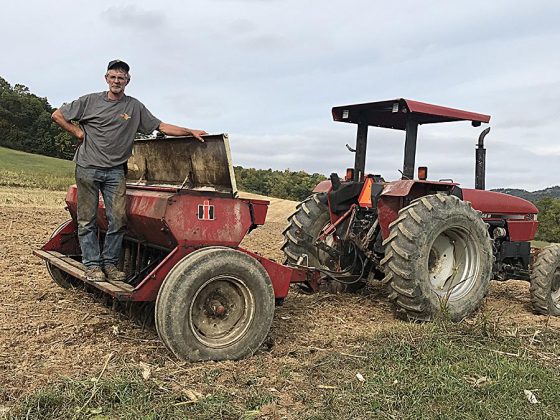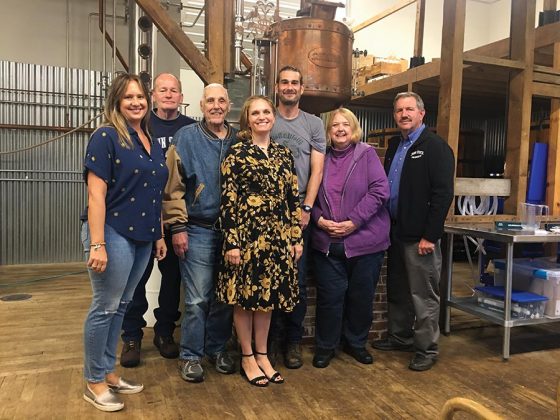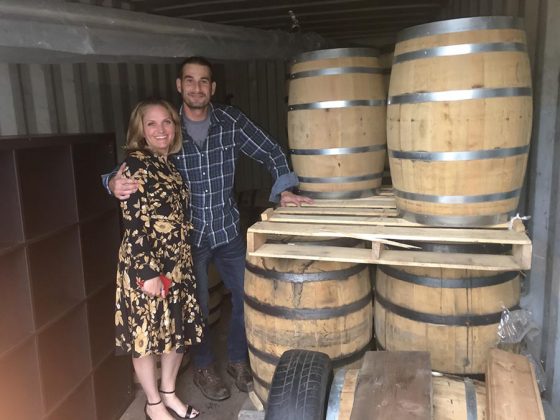While observing her mother’s nonprofit, Flint Hill Farm Educational Center in Coopersburg, PA, Laura Fields noticed that, although the adults were happy to buy lots of cheese, they weren’t benefiting like the kids from the educational programming. Already keyed into distillates, the younger Fields developed a new program linking the locally dominant sector of grain agriculture to that of the reemergence of whiskeys in a grain-to-glass story and various projects related to it.
“Adults quickly showed interest, just like bread lovers enjoy learning at bakeries and tasting samples,” she says. Motivated by watching her mother spin her wheels to combine her two revenue streams of attendance and sales, Fields began her own journey into the world of agricultural education, focusing on distilling rather than dairy products. An artist by training and heart, she founded the nonprofit Delaware Valley Fields Foundation (DVFF) as a platform for creating events that bring awareness of the role of small farms in our food and beverage systems.
DVFF’s big distilling event is its American Whiskey Convention, held annually in Philadelphia. While the concept of a whiskey convention was relatively new in Pennsylvania at the time, the national whiskey boom which had begun in the ’00s was perfectly timed. “In 2010, there were four distilleries in Pennsylvania, whereas now there are 134,” Fields says proudly, “spurred by a 2011 change in our state law.”
Fields is currently developing her first whiskey book, but she’s still very committed to another DVFF initiative, the Seed Spark Project, which is dedicated to bringing back heritage grains Pennsylvania was once known for. Until the 1920s, Pennsylvania was the largest American rye producer. Incidentally, rye isn’t native to the Americas; Fields holds that the first bushels arrived via immigrants coming to our shores from central and eastern Europe. “It’s an amazing crop. It grows in more situations than do other grains — rocky, sandy, clay soils — and doesn’t care for fertilizers and such,” but is easily subject to cross-pollination, especially between sibling ryes and wheat (from which triticale is derived). The Rosen variety was named for a circa-1903 Russian varietal which took Pennsylvania farmers by storm with its dynamic flavor profile and ease of growing. However, within seven planting seasons it had crossed with local ryes and lost its uniqueness. Isolated Rosen grains were then taken to Lake Michigan’s Manitou Island to breed for stock propagation.
To create scalable growth in rye production and usage, Fields admitted that “the rye grain infrastructure in Pennsylvania must be strengthened.” She said it’s hard for Pennsylvania craft distilleries to purchase bulk orders other than 50-lb bags or one-ton totes that can be used immediately from local suppliers, asking “where are they going to put it?” Shipping quantities of grain from the farm to the distillery incrementally has been difficult due to poor communication between suppliers and buyers. To develop growth advantageous to both parties’ infrastructures, storage and quality control must be addressed.
As distilleries grow, so will the need for more farmland to be planted. “Experimenting with two acres could eventually grow into 100,” says Fields, “and I’ve lobbied the PA Farm Bureau to recommend federal and state tax credits be given to incentivize the building of storage bins and the use of drying equipment for grains.” A farmer must first be willing to plant, grow, harvest and clean rye, a grain whose production and processing varies considerably from that of the dominantly grown wheat and corn. Rye necessitates different equipment and knowledge, as well as drying and storage facilities — changes requiring investment of time and capital. Her aforementioned AWC has created a platform for craft distilleries to meet with small local growers, millers, processors and maltsters and form partnerships that will encourage sensible business growth.
The major pivot point for distilleries is storage. Stoll & Wolfe (S&W) Distillery’s co-owner, Avianna Ponzi Wolfe, explains that, “There’s no economy of scale now available, so buying locally made malts can’t compare with the lower cost of larger operations outside Pennsylvania. Even if money weren’t an issue, there’s not enough desirable malt for distillers. Distillers are looking for more diastatic power in their malts.”
Until the 1970s, Rosen was one of the dominant types of rye grown in Pennsylvania, owing in no small part to having been marketed by Michter’s as a preferred distilling grain since the 1950s. It’s taken four years of growing Fields’ Keystone Rosen rye to yield her enough for a distillation run using over 500 pounds of rye for a 1,000-pound mash that included corn and barley, producing about 50 gallons of spirit. “This year we’ve planted four acres total within three locations — Furnace (where Penn State Extension’s experimental crop fields are located), Doylestown and Imler — a slow process we hope growers will be able to exponentially ramp up their production from. I want to ensure Pennsylvania farmers benefit from this,” Fields affirmed, “becoming recognized for being a specialty rye grower that distillers in other states will come to. The farmers will then be encouraged to diversify their crops, and we’ll have an identifiable brand in promoting it.”
Penn State emeritus faculty in plant science Greg Roth had been working with value-added grain crops to supplement the more common commodity crops. He knew Philadelphia suburban and urban residents would recognize the opportunities of using local grains in breads, non-GMO feeds and the brewing and distilling industries. “If you can come up with an enterprise valuable enough to keep your children on the land, such as growing organically or heirloom grains to bake, this allows for concentration of less land farmed for a greater return on investment. Seeing the development of smaller farmers, millers and distillers is immensely satisfying,” he says.
In 2016 he’d informed Fields that he had a small harvest of Rosen rye without a useful destination, and Fields stepped in to financially support the continued development of the seed. After the fourth harvest in July of 2019, the DVFF had finally propagated enough Rosen rye to distribute sizable amounts to other growers. Robert McDonald of Dancing Star Farms, who provides heirloom corn varieties to local distilleries and is also working with truly ancient grains such as emmer and einkorn, was the first farm recipient of Rosen. The 200-pound donation allowed him to plant two acres in October 2019, to be harvested in August 2020, which is expected to yield 2,000 pounds. “If none is taken for distilling, I’ll have enough to plant 20 acres,” though he awaits word from Penn State and Fields to see what they’d prefer to do with it for 2020’s planting. “My farm plants it in a secluded area, without contamination of other rye species, to maintain its purity.” With the addition of the Rosen, despite yielding a third of the Danko variety, McDonald is confident of sparking interest in Rosen rye.
John M. Urbanchuk, assistant professor of agribusiness at Delaware Valley University, is the second recipient of DVFF’s Rosen rye donations and is aiding in the study to determine how well Rosen grows in three different conditions in Pennsylvania. His own work with Rosen is notable in that the 2019 Rosen harvested at DVU was grown under certified organic conditions “providing students in plant science and organic farming with hands-on experience with a potentially important grain,” though what’s been used commercially at Stoll & Wolfe so far has been from a plot using inhibitors to minimize shoot growth, an ongoing issue with rye. According to Fields, all information garnered through Penn State’s research is given to any interested grower at no obligation. Though working with other rye varieties such as Sangaste and Dylan, Fields is trying to identify and promote the economic viability of Rosen in that “the proof is in distilling and tasting it!”
“In 2016, I was asked to join this project, advising on the mashing and distilling,” shared S&W’s 85-year-old master distiller, Dick Stoll. The last master distiller at Pennsylvania’s Michter’s distillery began as a ditchdigger, eventually trained by Charles Everett Beam to distill its bourbon and that of the A.H. Hirsch’s brand, among others, until it shuttered in 1990. During his tenure he witnessed the falloff of interest and use of Rosen, using it exclusively until it lacked sufficient supplies. “Pennsylvania’s a rye whiskey state, so our format at S&W will always lean toward it,” though rye accounts for less than 20% of its bourbon mash.
Lancaster County native and distillery partner, Erik Wolfe, has distiller blood running through his veins via his father and supporting player Jim with other spokes on the S&W wheel comprising Brett Carson, Colin Camac, David Cole, and Erik’s wife and partner, Avianna. Wolfe’s first few runs were too clean for his taste, requiring he “funk it up” a bit. “It’s amazing having to learn my new system [a 12 in. column still], working the gremlins out. The diameter is indicative of capacity, with our mash contained within 5–8 minutes. So, we’re able to extract exactly what we want before it goes into our pot for a second run,” a practicality founded upon inspiration. S&W whiskeys first ferment and flocculate in “sunk” cypress fermenters and are later aged in oak barrels of 53 and 30 gallons. The still and other portions of the distillery incorporate bricks salvaged from the former Michter’s site.
I was able to taste what will soon be the first Rosen rye sold in half a century and, with a mash bill of 65% Rosen rye, intensely flavorsome it was! The run I was on-hand for, after being proofed down to 109 before entering a barrel for at least two years of aging (in the trucking container pictured), will be bottled as American Straight Rye Whiskey.











